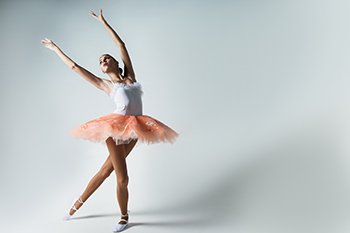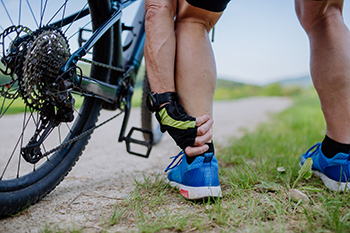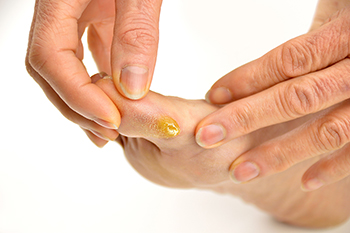Items filtered by date: July 2024
Risk Factors and Causes of Dance Injuries

Dance is an activity enjoyed by many for fun, recreation, and health benefits. It can be social, performed for an audience, ceremonial, or competitive. However, the diverse range of movements and techniques involved in different dance styles, ranging from ballroom to jazz, ballet to hip-hop and belly dancing, can lead to injuries if not approached with care. Beginners are particularly vulnerable due to inexperience and lack of technique. Additionally, poor fitness, improper posture, and fatigue contribute to the risk of sustaining a dance injury. Over-training and not allowing injuries to heal properly can also lead to chronic issues. To minimize these risks, dancers should warm up thoroughly, stay hydrated, wear appropriate footwear, and not push beyond their limits. Consulting a podiatrist can be beneficial for preventing and managing dance injuries, especially those involving the foot and ankle. If you have sustained a dance injury, it is suggested that you schedule an appointment with a podiatrist for an exam, diagnosis, and treatment options.
Sports related foot and ankle injuries require proper treatment before players can go back to their regular routines. For more information, contact Shaun J. Limon, DPM and Lisa Griffith-Limon, DPM of Limons Foot & Ankle Care. Our doctors can provide the care you need to keep you pain-free and on your feet.
Sports Related Foot and Ankle Injuries
Foot and ankle injuries are a common occurrence when it comes to athletes of any sport. While many athletes dismiss the initial aches and pains, the truth is that ignoring potential foot and ankle injuries can lead to serious problems. As athletes continue to place pressure and strain the area further, a mild injury can turn into something as serious as a rupture and may lead to a permanent disability. There are many factors that contribute to sports related foot and ankle injuries, which include failure to warm up properly, not providing support or wearing bad footwear. Common injuries and conditions athletes face, including:
- Plantar Fasciitis
- Plantar Fasciosis
- Achilles Tendinitis
- Achilles Tendon Rupture
- Ankle Sprains
Sports related injuries are commonly treated using the RICE method. This includes rest, applying ice to the injured area, compression and elevating the ankle. More serious sprains and injuries may require surgery, which could include arthroscopic and reconstructive surgery. Rehabilitation and therapy may also be required in order to get any recovering athlete to become fully functional again. Any unusual aches and pains an athlete sustains must be evaluated by a licensed, reputable medical professional.
If you have any questions please feel free to contact our office located in Lakewood Ranch, FL . We offer the newest diagnostic and treatment technologies for all your foot and ankle needs.
Ankle Pain While Cycling

Ankle pain while cycling can stem from various factors related to bike fit, technique, or underlying conditions. Improper bike setup, such as incorrect saddle height or pedal position, can strain the ankles during pedaling. Poor cycling techniques, like excessive ankle flexion or inadequate warm-up, may also contribute to discomfort. Common parts of the ankle affected by cycling include the Achilles tendon, which can become inflamed due to repetitive motion, and the ankle joint itself, which is susceptible to overuse injuries like sprains or strains. Additionally, conditions such as tendonitis or arthritis can exacerbate pain. Ensuring proper bike fit, warming up before rides, and maintaining good ankle flexibility and strength through targeted exercises can help prevent ankle pain. If you enjoy cycling and have endured an ankle injury, it is suggested that you consult a podiatrist who can offer treatment solutions, in addition to providing ankle injury prevention tips.
Ankle pain can have many different causes and the pain may potentially be serious. If you have ankle pain, consult with Shaun J. Limon, DPM and Lisa Griffith-Limon, DPM from Limons Foot & Ankle Care. Our doctors will assess your condition and provide you with quality foot and ankle treatment.
Ankle pain is any condition that causes pain in the ankle. Due to the fact that the ankle consists of tendons, muscles, bones, and ligaments, ankle pain can come from a number of different conditions.
Causes
The most common causes of ankle pain include:
- Types of arthritis (rheumatoid, osteoarthritis, and gout)
- Ankle sprains
- Broken ankles
- Achilles tendinitis
- Achilles tendon rupture
- Stress fractures
- Tarsal tunnel syndrome
- Plantar fasciitis
Symptoms
Symptoms of ankle injury vary based upon the condition. Pain may include general pain and discomfort, swelling, aching, redness, bruising, burning or stabbing sensations, and/or loss of sensation.
Diagnosis
Due to the wide variety of potential causes of ankle pain, podiatrists will utilize a number of different methods to properly diagnose ankle pain. This can include asking for personal and family medical histories and of any recent injuries. Further diagnosis may include sensation tests, a physical examination, and potentially x-rays or other imaging tests.
Treatment
Just as the range of causes varies widely, so do treatments. Some more common treatments are rest, ice packs, keeping pressure off the foot, orthotics and braces, medication for inflammation and pain, and surgery.
If you have any questions, please feel free to contact our office located in Lakewood Ranch, FL . We offer the newest diagnostic and treatment technologies for all your foot care needs.
Various Types of Toenail Fungus

Toenail fungus manifests in several forms, each with distinct characteristics. Subungual onychomycosis is the most common type, occurring beneath the nail plate and leading to thickened, discolored, and brittle nails. White superficial onychomycosis affects the nail's surface, causing white, crumbly spots that can spread and cover the entire nail if untreated. Candida onychomycosis, caused by yeast, often targets nails already damaged or exposed to moisture. This type results in swelling, pain, and a yellow-brown discoloration. Proper diagnosis by a podiatrist is essential to determine the specific type of infection and appropriate treatment. Antifungal medications, whether topical or oral, are typically used to combat these infections, helping restore nail health and prevent further complications. If you have developed a toenail fungus, it is strongly suggested that you confer with a podiatrist who can effectively treat the type you have.
For more information about treatment, contact Shaun J. Limon, DPM and Lisa Griffith-Limon, DPM of Limons Foot & Ankle Care. Our doctors can provide the care you need to keep you pain-free and on your feet.
Toenail Fungus Treatment
Toenail fungus is a condition that affects many people and can be especially hard to get rid of. Fortunately, there are several methods to go about treating and avoiding it.
Antifungals & Deterrence
Oral antifungal medicine has been shown to be effective in many cases. It is important to consult with a podiatrist to determine the proper regiment for you, or potentially explore other options.
Applying foot powder on the feet and shoes helps keep the feet free of moisture and sweat.
Sandals or open toed shoes – Wearing these will allow air movement and help keep feet dry. They also expose your feet to light, which fungus cannot tolerate. Socks with moisture wicking material also help as well.
If you have any questions please feel free to contact our office located in Lakewood Ranch, FL . We offer the newest diagnostic tools and technology to treat your foot and ankle needs.
Foot Blisters May Be Linked to Diabetes

Diabetic foot blisters are a concerning complication for people managing diabetes, primarily due to nerve damage and poor circulation. Friction blisters often occur in diabetics with neuropathy, where the lack of pain sensation leads to unnoticed skin rubbing and blister formation. One type of blister specific to diabetes can appear spontaneously and without inflammation, while posing a high risk for secondary infections. Certain fungal infections also contribute to blister formation, especially in warm, moist areas, such as between the toes. A podiatrist plays an essential role in managing these complications by providing regular foot exams and identifying early signs of blister formation. This foot doctor also can educate patients on proper foot care practices to prevent blisters, such as choosing suitable footwear and maintaining good hygiene. For fungal infections, a podiatrist can prescribe effective antifungal medications and monitor the healing process. If you are experiencing diabetic foot blisters, it is suggested that you make an appointment with a podiatrist for an exam and treatment.
Blisters may appear as a single bubble or in a cluster. They can cause a lot of pain and may be filled with pus, blood, or watery serum. If your feet are hurting, contact Shaun J. Limon, DPM and Lisa Griffith-Limon, DPM of Limons Foot & Ankle Care. Our doctors can provide the care you need to keep you pain-free and on your feet.
Foot Blisters
Foot blisters are often the result of friction. This happens due to the constant rubbing from shoes, which can lead to pain.
What Are Foot Blisters?
A foot blister is a small fluid-filled pocket that forms on the upper-most layer of the skin. Blisters are filled with clear fluid and can lead to blood drainage or pus if the area becomes infected.
Symptoms
(Blister symptoms may vary depending on what is causing them)
- Bubble of skin filled with fluid
- Redness
- Moderate to severe pain
- Itching
Prevention & Treatment
In order to prevent blisters, you should be sure to wear comfortable shoes with socks that cushion your feet and absorb sweat. Breaking a blister open may increase your chances of developing an infection. However, if your blister breaks, you should wash the area with soap and water immediately and then apply a bandage to the affected area. If your blisters cause severe pain it is important that you call your podiatrist right away.
If you have any questions, please feel free to contact our office located in Lakewood Ranch, FL . We offer the newest diagnostic and treatment technologies for all your foot care needs.
Severe Corns and Calluses on the Feet
 Severe calluses are thickened areas of skin that develop on the feet due to repeated pressure or friction. They often occur on the heels, soles, and sides of the feet. Corns are similar to calluses but are smaller, with a hard center surrounded by inflamed skin, typically forming on the toes. These conditions can happen as a result of wearing tight or ill-fitting shoes, high-heeled shoes, or abnormal gait patterns. Calluses look like rough, thick patches of skin, while corns appear as hard, round bumps. They can cause discomfort, pain, and tenderness, making walking difficult. Relief can consist of soaking the feet in warm water, using pumice stones or foot files to remove thickened skin, moisturizing, and wearing properly fitted shoes. Complications can arise if calluses and corns are left untreated, leading to skin ulcers or infections, especially in individuals with diabetes. If you suffer from these ailments, it is suggested that you schedule an appointment with a podiatrist who can effectively treat uncomfortable corns and calluses.
Severe calluses are thickened areas of skin that develop on the feet due to repeated pressure or friction. They often occur on the heels, soles, and sides of the feet. Corns are similar to calluses but are smaller, with a hard center surrounded by inflamed skin, typically forming on the toes. These conditions can happen as a result of wearing tight or ill-fitting shoes, high-heeled shoes, or abnormal gait patterns. Calluses look like rough, thick patches of skin, while corns appear as hard, round bumps. They can cause discomfort, pain, and tenderness, making walking difficult. Relief can consist of soaking the feet in warm water, using pumice stones or foot files to remove thickened skin, moisturizing, and wearing properly fitted shoes. Complications can arise if calluses and corns are left untreated, leading to skin ulcers or infections, especially in individuals with diabetes. If you suffer from these ailments, it is suggested that you schedule an appointment with a podiatrist who can effectively treat uncomfortable corns and calluses.
If you have any concerns regarding your feet and ankles, contact Shaun J. Limon, DPM and Lisa Griffith-Limon, DPM of Limons Foot & Ankle Care. Our doctors will treat your foot and ankle needs.
Corns: What Are They? and How Do You Get Rid of Them?
Corns can be described as areas of the skin that have thickened to the point of becoming painful or irritating. They are often layers and layers of the skin that have become dry and rough, and are normally smaller than calluses.
Ways to Prevent Corns
There are many ways to get rid of painful corns such as wearing:
- Well-fitting socks
- Comfortable shoes that are not tight around your foot
- Shoes that offer support
Treating Corns
Treatment of corns involves removing the dead skin that has built up in the specific area of the foot. Consult with Our doctors to determine the best treatment option for your case of corns.
If you have any questions please feel free to contact our office located in Lakewood Ranch, FL . We offer the newest diagnostic and treatment technologies for all your foot and ankle needs.


